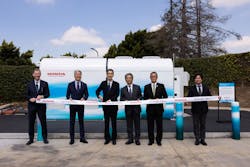Honda installs H2 Fuel Cell Station as Backup Power at U.S. HQ
Global automotive giant Honda has commenced operation of a stationary fuel cell power station on its U.S. corporate campus in Torrance, California, as part for its efforts to commercialize zero-emission backup power generation.
The fuel cell power station, which is now fully operational, supplies clean and quiet emergency backup power to the data center located on the campus of American Honda Motor. Honda plans to apply a next-generation stationary fuel cell system to its manufacturing facilities and data centers worldwide in the coming years to reduce its greenhouse gas emissions.
The demonstration program utilizes Honda’s expertise in hydrogen fuel cell technology and aligns with the company’s global objective to achieve carbon neutrality for all products and corporate activities by 2050.
The demonstration unit has a capacity of about 500 kW and reuses the fuel cell systems of previously leased Honda Clarity Fuel Cell vehicles. The design allows for the output to increase every 250 kW by packaging four fuel cells. The layout of the fuel cell units can be customized to suit the installation environment and to accommodate different packaging configurations.
Honda says its future stationary fuel cell units intended for commercialization will use the company’s next-generation fuel cell system, which is jointly developed with General Motors and will also power a new fuel cell electric vehicle (FCEV) based on the Honda CR-V, set to launch in 2024.
The power requirements of data centers have been growing rapidly in recent years due to the expansion of cloud computing and big data utilization, leading to an increasing need for backup power sources from a business continuity planning (BCP) perspective. The Torrance fuel cell station also serves as a proof of concept for the commercialization of the power generation unit, Honda says.
Data centers require uninterrupted and reliable power, as any disruption can lead to downtime or problems such as damage to servers or data corruption. Traditional backup generators that rely on diesel fuel contribute to carbon emissions and local air pollutants. However, backup power systems that use hydrogen fuel cells offer a promising solution for clean and dependable power generation, especially when using “green hydrogen” made from renewable sources, with water vapor being the only emission. Additionally, hydrogen can be stored and transported with a high energy density and can be refilled in a short time.
“We believe there's great promise in hydrogen fuel cells for backup power and offsetting potential peak power events,” said Koji Moriyama, Project Lead of the stationary fuel cell and Principal Engineer with American Honda R&D Business Unit. “By installing and utilizing our core technology, the fuel cell system, in various applications such as stationary power generation, Honda aims to stimulate hydrogen usage and provide clean energy for potential commercial customers.”
Honda says it is striving to create a circular economy to maximize the useful life of materials in its products, including the fuel cell systems of Honda Clarity Fuel Cell vehicles, for demonstration stationary fuel cell units. By developing recovery systems to recapture materials from end-of-life products, Honda notes it can reuse, refurbish, repurpose and recycle them into new products and foster a circular economy.
About the Author
EnergyTech Staff
Rod Walton is senior editor for EnergyTech.com. He has spent 17 years covering the energy industry as a newspaper and trade journalist.
Walton formerly was energy writer and business editor at the Tulsa World. Later, he spent six years covering the electricity power sector for Pennwell and Clarion Events. He joined Endeavor and EnergyTech in November 2021.
He can be reached at [email protected].
EnergyTech is focused on the mission critical and large-scale energy users and their sustainability and resiliency goals. These include the commercial and industrial sectors, as well as the military, universities, data centers and microgrids.
Many large-scale energy users such as Fortune 500 companies, and mission-critical users such as military bases, universities, healthcare facilities, public safety and data centers, shifting their energy priorities to reach net-zero carbon goals within the coming decades. These include plans for renewable energy power purchase agreements, but also on-site resiliency projects such as microgrids, combined heat and power, rooftop solar, energy storage, digitalization and building efficiency upgrades.
